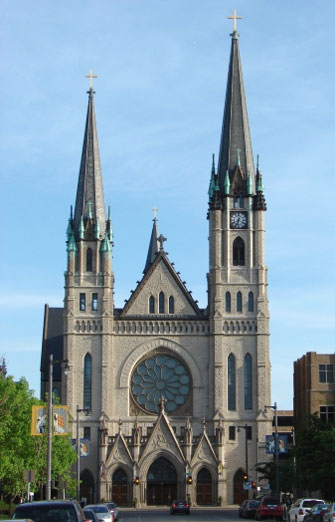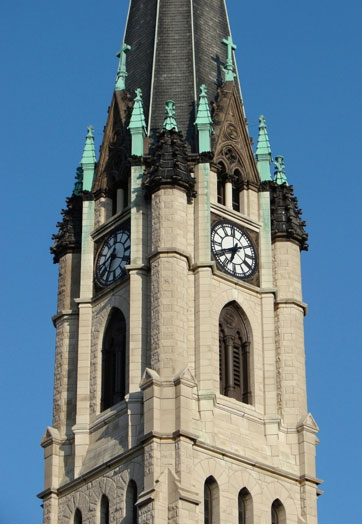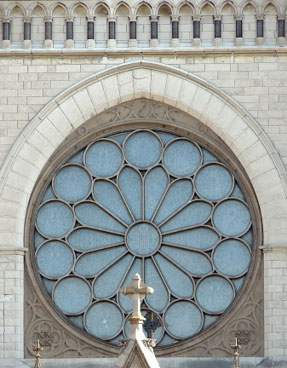35. Catholic Church of the Gesu, 1893
1145 West Wisconsin Avenue
Architect: Henry C. Koch and Company
The Church of the Gesu is a parish church named for the Gesu Church in Rome, the mother church of the Jesuit religious order. The Milwaukee parish was formed by the merger of two older Catholic parishes, St. Gall’s and Holy Name, which were administered by the Jesuits. Both of these earlier parishes were made up primarily of Irish immigrants and their descendants.
The two parishes were merged at the urging of Father Stanislaus Lalumiere, who was serving at St. Gall’s at the time. The new parish acquired land for the Gesu Church at 12th Street and Grand Avenue (now Wisconsin Avenue), about ten blocks west of St. Gall’s. Construction of the present church began in the early 1890s, with the cornerstone laid in May of 1893. This was just a few months after the disastrous Third Ward fire of October 1892, which destroyed 20 city blocks and left nearly 2,000 residents homeless. Most of the displaced residents were Irish immigrants and members of St. Gall’s Parish, many of whom relocated farther west, to the vicinity of the Gesu Church which was then under construction.
Father Lalumiere was also instrumental in securing the charter for Marquette College, and served as the college’s president beginning in 1887. Although the area surrounding the Gesu Church was primarily residential well into the twentieth century, the growth of the Marquette University campus gradually displaced most of the residential buildings. While the Gesu Church remains a parish church, it is also part of the Marquette campus and serves Marquette’s Catholic students.
Father Lalumiere turned to the architect Henry C. Koch to design the new church. At that time, H.C. Koch and Company was one of the most prominent architectural firms in the city, with commissions for both the Pfister Hotel and Milwaukee’s City Hall underway concurrently with that of the Gesu Church.
Just two blocks east of the Gesu Church is Calvary Presbyterian, designed a bit more than two decades earlier by the partnership of Henry Koch and Julius Hess. Comparing the two churches shows the evolution of Koch’s work as well as the evolution of the Gothic Revival style over this period. The exterior of Calvary Presbyterian, like many other Gothic Revival churches of its time, seems almost fussy in its profusion of details, including buttresses, pilasters, stringcourses, corbeled arcades, window hoods, etc. The Gesu Church appears relatively restrained by comparison. Part of the difference is attributable to the different building materials. Calvary Presbyterian is constructed of brick, which lends itself to small-scale details, while the Gesu Church is built of large blocks of Indiana limestone. But the differences also stem from a deliberate effort on the part of the architect toward simplicity and refinement, moving away from what was increasingly seen by the 1890s as an outdated approach to Gothic Revival church design.
In its façade composition, the Gesu Church bears some resemblance to Chartres Cathedral in France, built in the late twelfth and early thirteenth centuries. Like Chartres, the Gesu church has two towers of unequal height, a large rose window, and a blind arcade across the top of the façade that covers the lower portion of the front gable. (At Chartres, there are statues beneath each of the arches in the blind arcade.) The two steeples of the Gesu Church are the tallest and third-tallest of any church in Milwaukee. (The second-tallest steeple is that of St. Michael’s Catholic, built just prior to the Gesu Church about one mile to the northwest at 24th and Cherry Streets.) The northwest tower and steeple reach a height of 250 feet to the top of the gold cross, while the northeast tower is 213 feet in height. At 28 feet in diameter, the Gesu Church also has the city’s largest rose window.
The projecting front entrance with its three gable-topped portals is an addition dating to 1902, designed by the Milwaukee architect Herman Esser. The original entrance is intact and now forms the inner wall of the entrance vestibule. The 1902 addition is of limestone that matches the rest of the building in color, but the stones are cut to a smooth finish in contrast to the quarry-faced stone of the original building.
The building includes a lower church on the ground level and an upper church one floor above. As originally designed, the upper church could accommodate nearly 2,000 worshippers, making it the largest church in the city at that time. The Gesu Church held this distinction for only a few years, however, until the dedication of St. Josaphat’s Catholic on the South Side in 1901.
Sources:
“50th Anniversary of Gesu Church, December 2, 1943.” Marquette Tribune, 1943.
Brielmaier, Sherer and Sherer, architects. Drawings for alterations to the Catholic Church of the Gesu, dated July 14, 1966. Wisconsin Architectural Archive, drawing set 31-84.
The Centennial of Gesu Parish, May 23, 1993 – December 16, 1994: the Laying of the Cornerstone. Gesu Parish, 1994.
Church of the Gesu: Seventy-fifth Anniversary, 1893-1968. Gesu Church, 1968.
Janett, Rev. J. P. “Gesu Congregation Traces its History Back to 1847,” Milwaukee Sentinel, December 11, 1926, page 18, column 2.
Johnston, James M. “Gesu Called ‘Chartres of Milwaukee,’” Milwaukee Sentinel, April 22, 1978, part 1, page 11, column 1.
Joslyn, Jay. “Gesu Church at Century Mark,” Milwaukee Sentinel, May 1, 1993, page 10A, column 1.
“Jubilee Sheds Golden Glow on Gray Stone of the Gesu,” Milwaukee Journal, November 22, 1943, part 2, page 1, column 1.
Koch, H. C. and Co., architects. Drawings for construction of the Catholic Church of the Gesu, undated. Wisconsin Architectural Archive, Milwaukee Central Library, drawing set 7-9.
O’Brien, William P. “Milwaukee Architect: Henry C. Koch.” M.A. Thesis, University of Wisconsin – Milwaukee, 1989.



